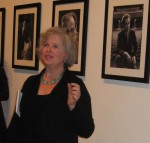Jennifer Levine, Fred Schiffer’s daughter, speaks at the opening of the exhibit of her father’s work. (photo by Cynthia Ramsay)
On April 16, with the help of volunteers from King David High School and others, the Jewish Museum and Archives of British Columbia welcomed more than 250 visitors to the opening night of Fred Schiffer Lives in Photos. At the Make Gallery until May 31, the exhibit is part of the Capture Photography Festival.
Michael Schwartz, coordinator of programs and development at the JMABC and curator of the exhibit, gave the crowd a brief overview of what the JMABC does, and how the Schiffer photos fit into the museum’s holdings.
Of the 300,000 photographs housed by the JMABC, said Schwartz, “The Schiffer collection comprises over 10,000 photos. The JMABC has been working on this collection – organizing it, processing it – since it was donated by Schiffer’s family in 2001. To date, we’ve digitized 2,000 photographs, which are available to researchers online. The 45 photos that you see in this exhibit are selected from those 2,000, and an additional six photos are on display at the atrium of the Langara library through May 4th in a satellite exhibit.”
Schwartz explained that Schiffer fled Vienna, seeking refuge in England, where he stayed for 10 years before heading to Argentina, where he also lived for 10 years. “He arrived here in Vancouver in 1958 with his wife Olive and their two young children, Jennifer and Roger.”
The Schiffers operated a small studio under the Hudson’s Bay Co. building, on Seymour Street. “Schiffer was respected by his peers, not only for his skill but for being a kind and generous man, a true mensch, as we say,” said Schwartz. “He was president of the local photographic association, wrote frequently for the association newsletter and shared his knowledge of the trade with his colleagues.” He was one of the people who “led the charge to develop a professional photography program at Langara.”
After thanking the partners and funders of the exhibit, as well as his colleagues, Schwartz introduced Jennifer Levine, Schiffer’s daughter, who attended the opening from Toronto.
While her father was the person behind the photographs, she said, “he had two quite remarkable women who loved him and worked with him”: her mother, “who was the person you would always meet in the studio and who was also the organizer and the bookkeeper,” and her aunt, Irene, “who was not only a master retoucher but, also, I think she did some of the printing … together they discussed how things should be, and collaborated to make the prints happen.”
The family came to Vancouver from Buenos Aires, which had a “very lively photographic culture and my father was part of a group of photographers who met together, collaborated, discussed their work … they were sophisticated, they had annual photo shows in art galleries,” said Levine. When he came here, he thought he could interest the Vancouver Art Gallery in his work. “The response was, ‘Oh no, that’s photography, that’s not art.’ And it’s interesting that Vancouver has become such … an international centre for exciting work in photography, but let me tell you that, in the ’50s and ’60s, that was not happening.”
For her father, she said, “coming to Vancouver, which he chose to do, I think, largely for his children … because he had a sense of what was happening in Argentina, meant that the exploratory and experimental nature of his work would have to be held in because people in Vancouver were not interested…. I see how he had to shape his work for the marketplace and I know he did it for us and I honor him for that…. Artists have to make compromises sometimes for the people they love, and my dad did. I’m really proud of him as a photographer but I’m proud of him as a dad, too.”
– With the video file of Wendy Fouks

